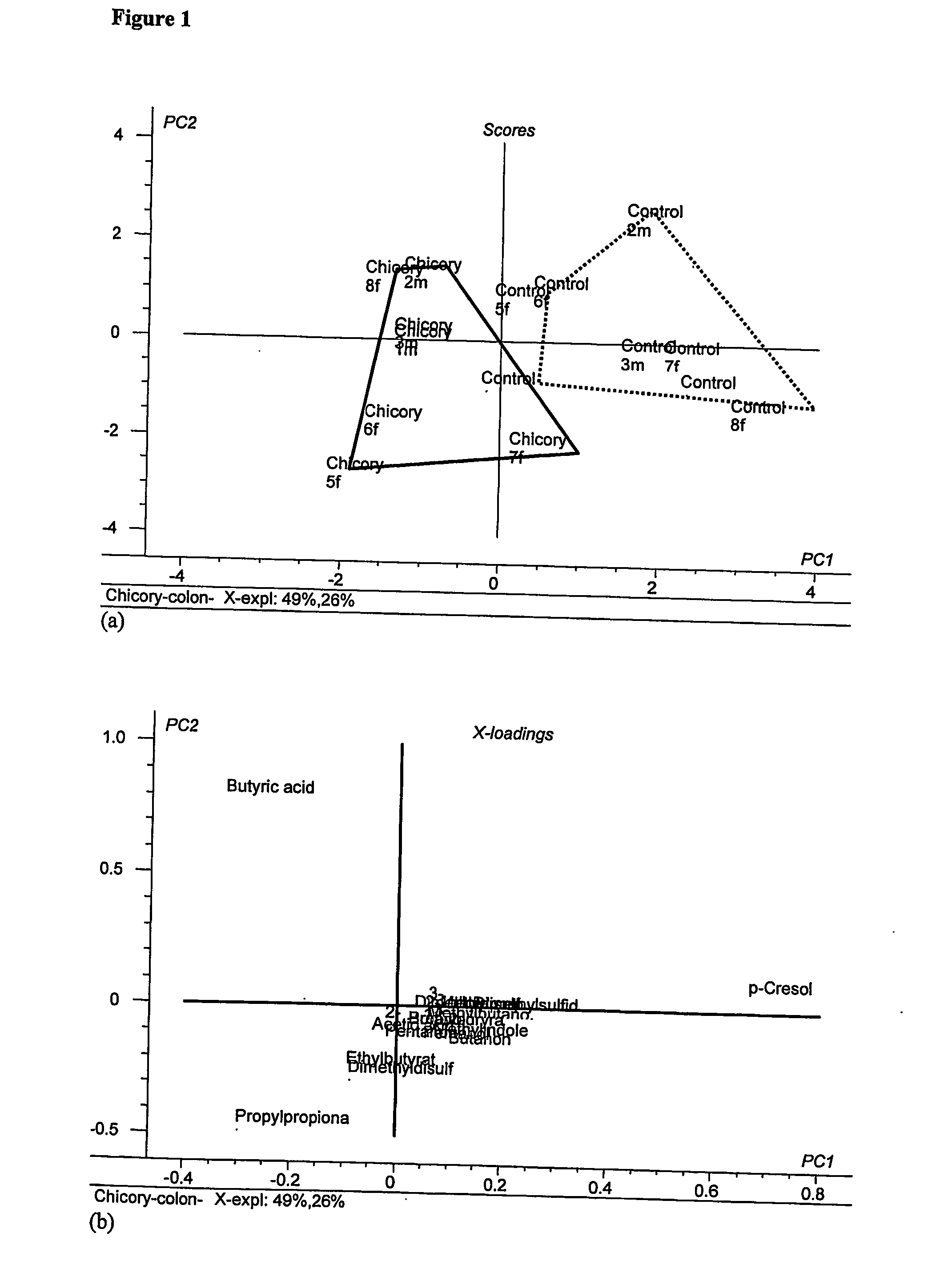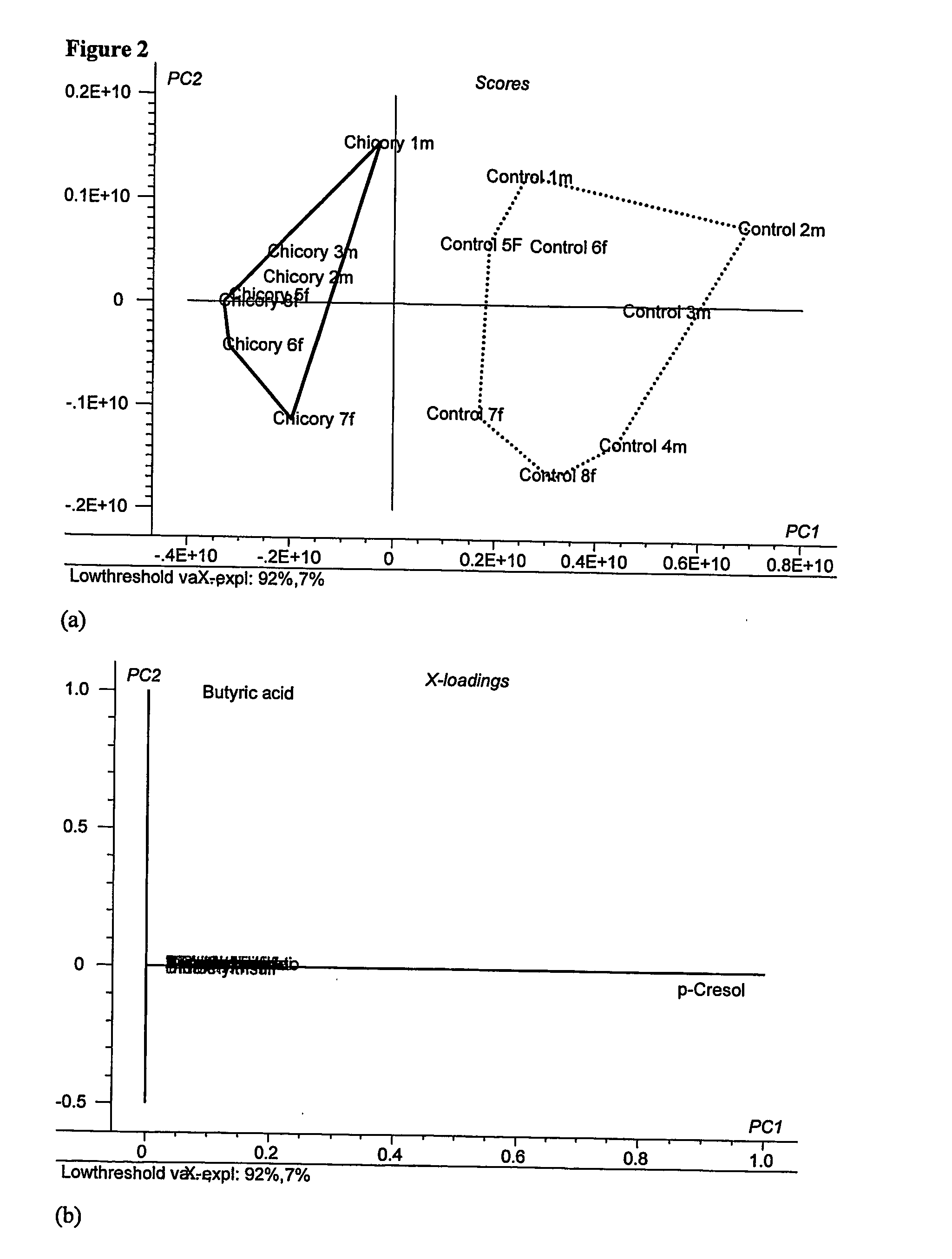Methodologies for improving the quality of meat, health status of animals and impact on environment
a technology for improving the health status of animals and improving the quality of meat, which is applied in the direction of monosaccharides, disaccharides, oligosaccharides, etc., can solve the problems of high-significant decrease in blood plasma skatole levels, reduce the amount of animals being rejected, and improve the taste, taste and aftertaste of meat, and reduce the skatole and androstenone conten
- Summary
- Abstract
- Description
- Claims
- Application Information
AI Technical Summary
Benefits of technology
Problems solved by technology
Method used
Image
Examples
example 1
Feeding with Chicory Roots Reduces the Amount of Odorous Compounds in Colon Contents of Pigs.
[0197] Alcohols and carboxylic acids are compounds with relatively negative odour impressions. When alcohols and carboxylic acids react, pleasant smelling asters are created and the result can be a less offensive odour impact. This can be illustrated by the reaction between ethanol and butyric acid, which results in ethylbutyrate, or by the reaction between propanol and butyric acid, which results in propylbutyrate.
Animals and Feed
[0198] The inulin content of chicory roots (variety Orchies) for the pig odour experiment was 15% on wet basis and the content of feed units for pigs was 27 FUp (pigs) per 100-kg chicory roots measured by chemical analysis. The experiment is a subset of an experiment, which consisted of 4 treatments each of eight pigs. The 32 pigs (16 intact male and 16 female pigs) were kept in litters of 8 pigs and fed 100% organic concentrate and semi ad libitum grass silag...
example 2a
Influence of Chicory Roots on Boar Taint (Skatole and Androstenone) in Pigs
Methods
Animals and Feed
[0215] An inulin-rich variety Orchies of chicory (Cichorium intybus L. var. Orehies) for fattening pig diets has been used in this experiment. The yield of the organically grown crop varied from 30 t / ha in one year and 40 t / ha the following year. The first year the inulin content (fructan) of the chicory roots of the variety Orchies was around 150 g per kg feed and contained 2.11 MJ net energy (0.27 feed units (FUp)) and 23.4 g digestive protein per kg feed of chicory roots. The pigs ate the high amount of fresh and bitter blended chicory roots (from 2.1-3.0 kg per day during the experimental period) without problems after one week of adaptation by giving individually increasing amounts of chicory roots during that week.
[0216] The first of two pig experiments consisted of 40 pigs (20 entire male and 20 female pigs), all free of parasite infections. The 40 pigs were kept in litter...
example 2b
Sensory and Chemical Investigations of Eating Quality of Pork in Relation to the Influence of Bioactive Forage Feeding
Influence of Chicory Roots (Fresh and Dried) and Inulin on Production and Boar Taint (Skatole and Androstenone) in Entire Male Pigs
[0226] The experiment was consisted of 4 treatments each of 8 entire male pigs. The male pigs were distributed to the 4 treatments according to litter and initial weight and the pigs were kept in individual pens. Four weeks prior to initiation of the experiment the 32 pigs were fed 100% organic concentrate diet according to scale plus ad libitum grass silage and were infected twice with parasites. Then the last 6 weeks prior to slaughter the pigs were fed according to the plan (see Table 9). Treatment 1 was an organic “control” treatment fed 95% organic concentrate plus clovergrass silage. Treatment 2 was fed 70% organic concentrate plus 25% bioactive blended fresh chicory roots. Treatment 3 was fed 70% organic concentrate plus 25% dr...
PUM
| Property | Measurement | Unit |
|---|---|---|
| Weight | aaaaa | aaaaa |
| Weight | aaaaa | aaaaa |
| Fraction | aaaaa | aaaaa |
Abstract
Description
Claims
Application Information
 Login to View More
Login to View More - R&D
- Intellectual Property
- Life Sciences
- Materials
- Tech Scout
- Unparalleled Data Quality
- Higher Quality Content
- 60% Fewer Hallucinations
Browse by: Latest US Patents, China's latest patents, Technical Efficacy Thesaurus, Application Domain, Technology Topic, Popular Technical Reports.
© 2025 PatSnap. All rights reserved.Legal|Privacy policy|Modern Slavery Act Transparency Statement|Sitemap|About US| Contact US: help@patsnap.com



